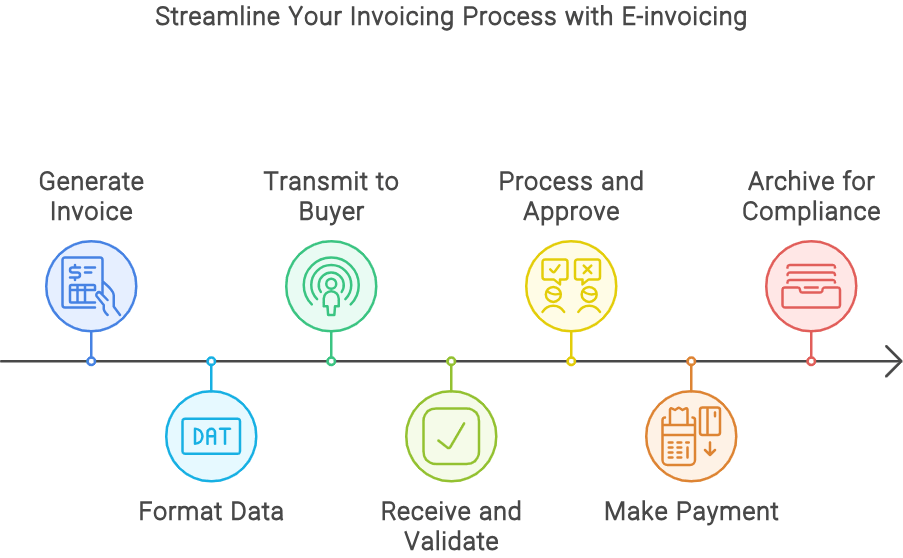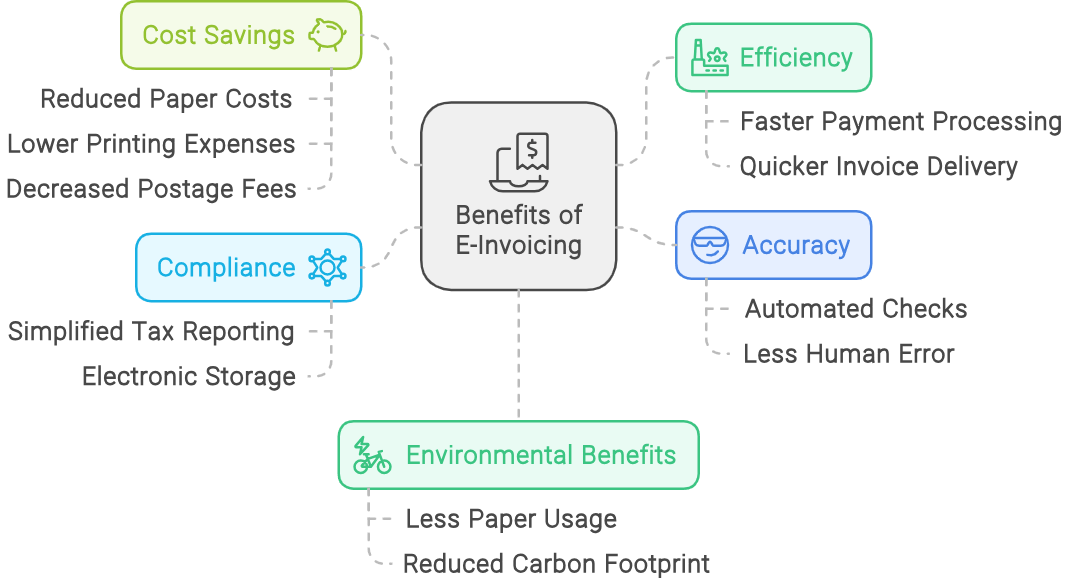Unlocking E-fficiency: How E-Invoicing Transforms Business in Malaysia – Frequently Asked Questions (E Invoicing FAQs)
Welcome to the future of invoicing, where paperwork meets cutting-edge technology. E-invoicing in Malaysia isn’t just a trend—it’s a game changer for businesses looking to streamline their operations and stay ahead of the curve. Here’s a straightforward guide to how e-invoicing works and why it’s essential for your business.
What is E-invoicing?: E-invoicing is a system where businesses issue invoices digitally rather than on paper. This process streamlines billing and payment, making it more efficient and reducing errors.
How It Works: Businesses create invoices through an electronic system. These invoices are then sent to a central platform managed by the government. This system verifies and records the invoices in real-time.
How Will This Help Me?: E-invoicing speeds up processing, helps with tax transparency and reduces the risk of fraud and mistakes. It also simplifies record-keeping and auditing.
Is E-Invoicing Mandatory?: Since August 1st, 2024, E-invoicing has been mandatory for businesses with annual sales of RM 100 million or more. This mandate will gradually extend to other companies. Below is the official implementation timeline for e-invoicing:
| Taxpayers with an annual turnover or revenue of more than RM100 million | August 1st, 2024 |
| Taxpayers with an annual turnover or revenue of more than RM25 million and up to RM100 million | January 1st, 2025 |
| Taxpayers with an annual turnover or revenue of more than RM150,000 and up to RM25 million | July 1st, 2025 |
You could learn more about the timeline here : https://www.hasil.gov.my/e-invois
E-Invoicing is not required for taxpayers with an annual turnover or revenue below RM150,000.
Who does NOT need to implement or use E Invoicing ?: Taxpayers running a business, with an annual turnover or revenue of less than RM150,000 are exempt (not required) from issuing e-invoices.
How about companies who are having an annual turnover of less than RM 150,000 but related to bigger companies earning more ?: Taxpayers running a business with an annual turnover or revenue of less than RM150,000 and but have shareholders, subsidiaries, related companies, or joint ventures with a higher turnover – they are NOT exempt (still have to use E Invoicing, even though revenue is less than RM 150,000.
What about individuals earning more than RM 150,000 per year? Do they have to use E Invoicing: Only individuals getting revenue from businesses. Salaried employees earning more than RM 150,000 per year do not have to use E Invoicing.
How do I implement E-Invoicing in my company?: You will have to link your invoice systems to the government’s e-invoicing platform. Approved service providers can also help with this connection. Talk to us -at Cad Training Centre to conduct a course for your team to help you with this transition (03-8063 0414).
Can I use E-Invoicing for overseas transactions?: Yes! You aren’t limited to only transactions within Malaysia. You can use it for cross-border transactions too.
What platform does the government use for e-invoicing? The MyInvois online portal is the central platform of choice for the LHDN.
Video on how to use My Invoice Portal
Here is a simplified process flow, of E Invoicing
How does the E-Invoicing process work?
E-invoicing is the electronic way of creating, sending, and managing invoices. Instead of using paper invoices, businesses use digital formats to streamline the process.
1. Set the Stage: Choose Your E-Invoicing System
Start by selecting an e-invoicing system that suits your requirements. Think of it as picking the right tool for the job. This system can be specialized software or an online service provider designed to handle all your invoicing needs efficiently.
2. Craft Your Digital Invoice
Once you’re set-up, it’s time to generate your invoices. Instead of using old-fashioned paper, your invoices are created in a digital format like XML or JSON. All the essential details—such as transaction information and tax numbers—are neatly packed into an electronic file.
3. Send It Out
With your invoice ready, it’s time for the magic of digital delivery. Upload your invoice to the Inland Revenue Board of Malaysia (LHDN) via the MyInvois portal.
4. Verification and Confirmation
The MyInvois portal will verify your invoice to ensure everything’s in order, like a digital checkpoint. Once your invoice is approved, you’ll receive a confirmation that everything is set for processing.
5. Secure Storage
After approval, it’s crucial to store your e-invoices securely. Digital storage keeps your documents safe and easily accessible for future reference and audits.
6. Enjoy the Benefits
Embracing e-invoicing brings a host of benefits: faster processing, fewer errors, and seamless compliance with tax regulations. It’s a win-win that simplifies your workflow and boosts efficiency.
By integrating e-invoicing into your business, you’re not only keeping up with the times—you’re leading the way towards a more streamlined, efficient future. Welcome to the new era of invoicing in Malaysia.
E-Invoicing FAQ
How quickly will LHDN validate an E-Invoice on MyInvois?
LHDN performs e-invoice validations in near real-time, often in just two seconds.
Do businesses need to issue an e-invoice on the same day as the transaction?
Not necessarily. Except for consolidated e-invoices, self-billed e-invoices related to the importation of goods or services, and e-invoices for foreign revenue, there are no strict timing requirements.
Can I create and save draft e-invoices on the MyInvois Portal before finalizing them?
Absolutely! You can draft and save e-invoices in the MyInvois Portal. The e-invoice will only be finalized and accepted once it passes validation.
How should taxpayers who aren’t currently using any invoicing system transition to e-invoicing?
Taxpayers are encouraged to use the MyInvois Portal, which is free for all users. For those seeking more support, engaging with third-party service providers can offer tailored solutions for a smooth transition to e-invoicing.
What if the MyInvois system is down?
The MyInvois Portal is up and running 99.97% of the time. If there’s ever a system outage, suppliers have 72 hours to submit e-invoices once the system is back online. In future implementations, your system will automatically retry sending e-invoices once the portal is operational again.
To avoid delays, make sure to frequently check the MyInvois Portal to see when it’s back up.
For the importation of goods, are the due dates for issuing self-billed e-invoices and consolidated self-billed e-invoices the same or different?
For self-billed e-invoices for importation of goods, the due date is latest by the end of the month following the month of obtaining customs clearance. Consolidated self-billed e-invoices, it is within seven (7) calendar days after the month’s end.
Does the MyInvois Portal allow for the editing of information after the e-invoice has been validated by LHDN?
No, the supplier must cancel the e-invoice within 72 hours of validation and reissue a new one.
Any modifications made after 72 hours from the time of validation would need the supplier to issue a new e-invoice (e.g., debit note, credit note, refund note e-invoice) to amend the original e-invoice issued. Following that, a new e-invoice would need to be sent.
Is there any adjustment window allowed for the supplier to cancel an invoice submitted to LHDN?
Yes, there is a 72-hour timeframe for the e-Invoice to be cancelled by the supplier.
Is there a grace period for businesses to migrate to e-invoicing?
The Malaysian government has granted a six-month grace period for e-invoicing fines to help businesses adjust to the new requirements. The grace period begins on August 1, 2024, allowing businesses until February 1, 2025, to comply without penalties.
What happens if I forget to issue an e-invoice?
Failure to issue an e-Invoice is an offence under Section 120(1)(d) of the Income Tax Act 1967 and will result in a fine of not less than RM200 and not more than RM20,000 or imprisonment not exceeding 6 months or both, for each non-compliance.
Are any industries exempted from the e-invoicing implementation?
Currently, no industries are excluded from the adoption of e-invoicing.
How can taxpayers start preparing for the e-Invoice implementation?
When implementing e-Invoicing, the three (3) primary factors to consider are:
- Human resources: Businesses are advised to assemble a dedicated team equipped with the necessary expertise and capabilities to prepare for the implementation.
- Business processes: Conduct a comprehensive review of the current process and procedures in issuing invoice transaction documents.
- Technology and systems: Confirm the availability of the necessary resources, data structures and existing IT capabilities to ensure the systems in place comply with the e-Invoice requirements.
What should I do if a client or supplier is not yet compliant with e-invoicing?
Communicate with your client or supplier to understand their status and plan for compliance. In the interim, you may need to follow alternative invoicing procedures as per RMCD guidelines, such as standard paper-based invoicing, until both parties are aligned with the e-invoicing requirements.
Example:-
Company A – Has already started E-Invoicing
Company B – Has not
Company B can issue a normal paper invoice to company A. Company A can use the receipt to substantiate tax.
What is the process for onboarding new suppliers or customers to e-invoicing?
Onboarding involves informing new suppliers or customers about your e-invoicing requirements, providing them with necessary documentation or training, and ensuring that their systems are compatible with your e-invoicing setup.
What are the technical requirements for e-invoicing?
Businesses need to have compatible software systems that can generate e-invoices in the required format and interface with the RMCD’s system. It may involve integration with accounting software and compliance with technical standards.
How can small businesses handle e-invoicing if they lack technical resources?
Small businesses can consider using cloud-based e-invoicing solutions that offer user-friendly interfaces and integration with existing accounting software. Additionally, consulting with IT service providers or e-invoicing experts can help facilitate the transition.
What should I do if I experience a system outage or downtime?
In the event of a system outage, have a contingency plan in place, such as maintaining paper-based invoicing temporarily, and notifying affected parties. Work with your IT team or service provider to resolve the issue as quickly as possible.
Can e-invoicing be integrated with other business processes?
Yes, e-invoicing can be integrated with other business processes such as inventory management, procurement, and financial reporting. Integration helps streamline operations and improve overall efficiency.
How does e-invoicing impact SST reporting?
E-invoicing facilitates more accurate and timely SST reporting by ensuring that all invoices are submitted in a standardized format, making it easier for both businesses and tax authorities to track and verify tax obligations.
How can businesses verify the authenticity of received e-invoices?
Verification can be done by checking the e-invoice against the details in your system, but not to worry. The MyInvois portal validates the authenticity of e-invoices automatically.
What should businesses do if they suspect fraud involving e-invoices?
If fraud is suspected, immediately report it to the RMCD and your internal compliance or security team. Take steps to investigate and mitigate the impact, and review your processes to prevent future occurrences.
How long should e-invoices be retained?
Businesses are generally required to retain e-invoices for a specified period, often in accordance with local tax laws and regulations. In Malaysia, this is typically 7 years. Ensure you have a reliable system for archiving and retrieving e-invoices.
E-Invoicing: Industry-Specific FAQ
Healthcare
Question: If a hospital implements e-Invoicing, can it continue its current invoicing process for staff medical expenses?
Answer: Yes, hospitals can maintain their existing invoicing procedures for staff medical expenses even after implementing e-Invoicing.
Question: Can hospitals issue separate bills for insurance-covered charges and patient-covered charges after implementing e-Invoice?
Answer: Yes, hospitals can still issue separate bills for insurance-covered and patient-covered charges. However, both bills must be in the form of an e-Invoice.
Construction
Question: Are e-Invoices required for charges issued to subcontractors, including penalties?
Answer: Yes, e-Invoices are mandatory for all charges billed to subcontractors, including any penalties incurred.
Question: How should contractors handle e-Invoices for progress claims related to property construction, particularly when certification of work done is required?
Answer: Contractors must issue e-Invoices for all progress claims. However, they have the option to issue the e-Invoice after obtaining the necessary certification if the work completion certificate is a prerequisite for payment.
eCommerce
Question: In transactions facilitated through an e-commerce platform, who is responsible for issuing e-Invoices to consumers?
Answer: The e-commerce platform provider holds the responsibility of issuing e-Invoices directly to consumers for transactions conducted through their platform.
Question: Can e-commerce platform providers consolidate income generated from multiple merchant e-commerce transactions into a single e-Invoice?
Answer: No, consolidating income from different merchants into a single e-Invoice is not permissible. Each merchant transaction must have a separate corresponding e-Invoice.
Oil & Gas
Question: When a contractor operating under a Production Sharing Contract (PSC) sells crude oil to a buyer, whose Tax Identification Number (TIN) should be used as the Supplier on the e-Invoice?
Answer: The contractor’s TIN, along with their corresponding details, should be used as the Supplier on the e-Invoice.
Question: Are e-Invoices required for inter-ledger transactions that occur between PSCs and operators?
Answer: No, as of now, e-Invoices are not required for inter-ledger transactions between PSCs and operators until further notice.
Want to learn more? At CAD Training Centre, you will learn not only to understand but master E-Invoicing – all in 1 day. 03-80630414






